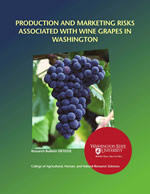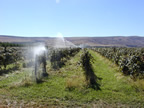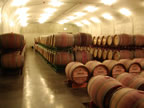Production and Marketing Risks Associated with Wine Grapes in Washington
By R.J. Folwell, B.D. Gebers, R. Wample, A.F. Aegerter, and T. Bales*
On-line only. The overall objective of this research was to conduct an economic analysis that accounts for both production and market risks of Cabernet Sauvignon, Chenin Blanc, and White Reisling wine grape vineyards in Washington. The production risk addressed is in terms of low wintertime temperatures killing the fruiting buds, and the market risk is in terms of resulting price variation as the market supply and demand changes. A computer simulation model was constructed that accounts for both risks, and results are discussed.
The Washington wine grape producing region has many similarities to other prominent wine grape producing areas throughout the world. The desirable climate conditions during the growing season and cold temperatures during the winter months help the vines achieve full dormancy...Bud kill is a major production risk that can reduce the tonnage the grower harvests and the profit level realized. This type of risk has occasionally precluded the investment in wine grape vineyards in Washington.
The overall objective of this research was to conduct an economic analysis which accounts for both production and market risks of Cabernet Sauvignon, Chenin Blanc, and White Riesling wine grape vineyards in Washington. The production risk addressed is in terms of low wintertime temperatures killing the fruiting buds and lowering yields. The market risk is in terms of resulting price variation as the market supply and demand changes. To account for both risks in a simultaneous fashion, a computer simulation model was constructed which combines weather (temperature) impacts on bud kill and yields which in turn impacts prices through price flexibility coefficients and costs of production. The simulation model was run 2,000 times over the assumed life of 19 years of a vineyard to determine the average net returns, internal rate of return (IRR) , net present value (NPV), and investment payback period by variety planted.
The analysis assumes that the producer does not employ any type of risk management strategies. Examples of such strategies would be the use of wind machines for possible protection against low winter temperatures or forward contracting at fixed prices to reduce market price variability.
*B.D. Gebers is a former graduate research assistant; R. Wample is a horticulturalist; A.F. Aegerter is a research associate; and T. Bales is a graduate research assistant.
For more indepth information see the viticulture and Enology site at http://www.wineducation.wsu.edu/. The Viticulture and Enology Education Consortium, includes WSU, Columbia Basin College, Walla Walla Community College, Wenatchee Valley Community College, Yakima Valley College and the Washington Wine Commission. The purpose of the Education Consortium is to better serve the growing needs of the Washington wine industry. One method to meet the growing needs is with the development of the new Viticulture and Enology degree option at Washington State University.
Heading using the h3 tag
Lorem ipsum dolor sit amet, consectetur adipisicing elit, sed do eiusmod tempor incididunt ut labore et dolore magna aliqua. Ut enim ad minim veniam, quis nostrud exercitation ullamco laboris nisi ut aliquip ex ea commodo consequat. Duis aute irure dolor in reprehenderit in voluptate velit esse cillum dolore eu fugiat nulla pariatur. Excepteur sint occaecat cupidatat non proident, sunt in culpa qui officia deserunt mollit anim id est laborum.




